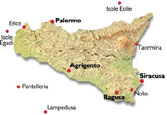|
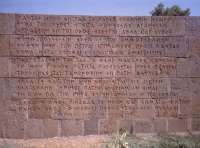 The Aeolian Islands (Isole Eolie) have been named since antiquity in honour of Aeolus, lord of the winds in Odyssey Book 7. There is nothing fanciful about this: you'll know what I mean if you've stood by the harbour in Lípari town with an autumn gale is lashing you in the face, powering the breakers towards the shore. You begin to wonder whether you'll be able to get away from the island in time for your plane home. Or you've taken what started as a gentle sun-warmed cruise to one of the other islands, which has turned into a maritime nightmare, reminding you of the storm in Aeneid Book 1. (O terque quaterque beati...!) The Aeolian Islands (Isole Eolie) have been named since antiquity in honour of Aeolus, lord of the winds in Odyssey Book 7. There is nothing fanciful about this: you'll know what I mean if you've stood by the harbour in Lípari town with an autumn gale is lashing you in the face, powering the breakers towards the shore. You begin to wonder whether you'll be able to get away from the island in time for your plane home. Or you've taken what started as a gentle sun-warmed cruise to one of the other islands, which has turned into a maritime nightmare, reminding you of the storm in Aeneid Book 1. (O terque quaterque beati...!)
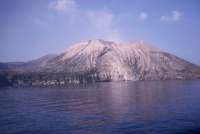 There's always a sense of adventure crossing that deceptively short stretch of water between the north coast of Sicily and the Aeolian Islands. I first visited on a day trip in 1993, taking the big, slow ferry from Milazzo. Gradually Vulcano appears through morning mist, apparently hovering just above the sea. As you sail nearer the steep sides look inaccessible - Homer's wall of bronze does not seem so incredible. When you round the corner, and begin entering the harbour you smell the smell. There is a mudpool full of wallowing tourist flab. The sensation is like simmering gently in a pan of thick soup made from Brussels Sprouts - and the aroma will cling for ever to any garment you may wear. After your malodorous marinade you pick your way over the pebbles to the sea, only a few yards away, and wash off the noxious crusty clay. There's always a sense of adventure crossing that deceptively short stretch of water between the north coast of Sicily and the Aeolian Islands. I first visited on a day trip in 1993, taking the big, slow ferry from Milazzo. Gradually Vulcano appears through morning mist, apparently hovering just above the sea. As you sail nearer the steep sides look inaccessible - Homer's wall of bronze does not seem so incredible. When you round the corner, and begin entering the harbour you smell the smell. There is a mudpool full of wallowing tourist flab. The sensation is like simmering gently in a pan of thick soup made from Brussels Sprouts - and the aroma will cling for ever to any garment you may wear. After your malodorous marinade you pick your way over the pebbles to the sea, only a few yards away, and wash off the noxious crusty clay.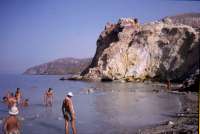 Some of the water is actually hot - the secret is to find a spot where hot and cold have blended to create the temperature of a perfect bath. You can also walk across to the black sand beach on the other side of the isthmus (which is where all the action on Vulcano takes place - between the main volcano and Vulcanello - a comparatively recent upstart). And if your masochistic tendencies are well-deveoped, you can hike up to the top of the Volcano after which all other volcanoes were named. It's been on the verge of extinction for centuries, but still manages to produce its quota of sulphurous vapour. Some of the water is actually hot - the secret is to find a spot where hot and cold have blended to create the temperature of a perfect bath. You can also walk across to the black sand beach on the other side of the isthmus (which is where all the action on Vulcano takes place - between the main volcano and Vulcanello - a comparatively recent upstart). And if your masochistic tendencies are well-deveoped, you can hike up to the top of the Volcano after which all other volcanoes were named. It's been on the verge of extinction for centuries, but still manages to produce its quota of sulphurous vapour.
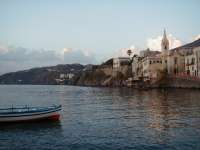 You'll soon reach Lípari if you stay on the ferry - but it's quicker to arrive by aliscafo [hydrofoil] , either from Milazzo or Messina (or even from Cefalu or Palermo). The hydrofoil costs twice as much and takes half the time. In 2000 we arrived by hydrofoil from Reggio di Calabria, having flown in to the tiny airport there; an alternative route to the Aeolian Islands well worth considering. I've spent two separate weeks on Lípari. Once was at the Hotel Carasco, above the rocks to the south of the town (a ten minute stroll from the centre), a pleasant modern hotel with good food, a large proper swimming pool, and splendid views from the bedrooms. You'll soon reach Lípari if you stay on the ferry - but it's quicker to arrive by aliscafo [hydrofoil] , either from Milazzo or Messina (or even from Cefalu or Palermo). The hydrofoil costs twice as much and takes half the time. In 2000 we arrived by hydrofoil from Reggio di Calabria, having flown in to the tiny airport there; an alternative route to the Aeolian Islands well worth considering. I've spent two separate weeks on Lípari. Once was at the Hotel Carasco, above the rocks to the south of the town (a ten minute stroll from the centre), a pleasant modern hotel with good food, a large proper swimming pool, and splendid views from the bedrooms. 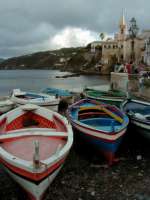
The second stay was at the Villa Meligunis, bang in the centre. This is a more luxurious place, with a wonderful roof-top restaurant and bar - sitting there as the day cools sipping a Malvasia and dunking amaretti is an idyllic way to unwind and start the evening. Malvasia - anglicised as Malmsey (though this is now used for a sugary wine from Madeira) - is a rich but tangy wine made locally, and it is so appreciated locally that the real thing is very difficult to get outside the islands, even elsewhere in Sicily. The nearest to it is the more widely obtainable Passito di Pantelleria - also a Sicilian island speciality, but Malvasia is better - the finest is from grapes grown on Salina.
Lípari has two harbours - the big boats come into the Marina Lunga, to the north of the town, the aliscafi to the Marina Corta to the south. Between the two is the upper town, where you'll find the Duomo and the Museo Eoliano. This museum holds the most important collection of ancient theatrical artefacts in the world - masks from tragedy, comedy and satyr plays, and sets of miniature terracotta figurines of actors from specific plays: anyone with an interest in classical drama will want to spent a long time here!
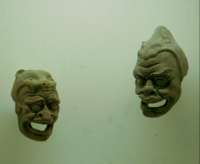 |
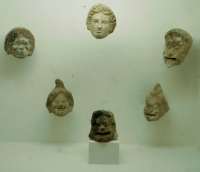 |
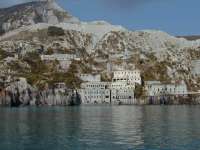 The rest of the island is worth exploring - either by road, or better by boat. From the sea you will see the pumice workings - a great chute of white falling into the sea. The sea floor is also white, making the water in this part of the island as clear and blue as a swimming pool. The little floating chunks of pumice are a little disconcering at first - especially to anyone who has attempted to bathe in the lagoon in Venice! (You can't swim, you just go through the motions ...). Pumice is still mined - it's a key ingredient of toothpaste apparently. The other island speciality, which brought Lípari its importance in prehistoric times, is obsidian, a black volcanic glass, which was valued for tools and weapons. The rest of the island is worth exploring - either by road, or better by boat. From the sea you will see the pumice workings - a great chute of white falling into the sea. The sea floor is also white, making the water in this part of the island as clear and blue as a swimming pool. The little floating chunks of pumice are a little disconcering at first - especially to anyone who has attempted to bathe in the lagoon in Venice! (You can't swim, you just go through the motions ...). Pumice is still mined - it's a key ingredient of toothpaste apparently. The other island speciality, which brought Lípari its importance in prehistoric times, is obsidian, a black volcanic glass, which was valued for tools and weapons.
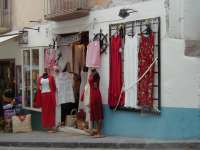 The best beach is to the north of the town at Canneto - take a bus, don't try and walk through the tunnel. Even better is Spiaggia Bianca, which necessitates a brisk climb at the northern end of the beach - this was quite magical in 1993, but has lost much of its white underwater pumice since then. The best beach is to the north of the town at Canneto - take a bus, don't try and walk through the tunnel. Even better is Spiaggia Bianca, which necessitates a brisk climb at the northern end of the beach - this was quite magical in 1993, but has lost much of its white underwater pumice since then.
There are plenty of good places to eat in Lípari town - I'd recommend Filippino (an institution since 1910), and the roof restaurant in the Villa Meligunis hotel - both expensive though.
Panarea is the most exclusive of the islands - tiny but with some very fine hotels and chic gift shops - good bathing here too (I swam ashore from the tour boat). The only vehicles are sort of electric golf trollies - the roads are just paths.
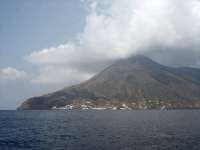 Salina (ancient Didyme - from the twin peaks, both extinct volcanoes) is a short boat trip from Lipari. We stopped at Rinella on the south coast, swam off Pollara (setting for Il Postino), saw Malfa - the largest town - only from the sea, and had lunch and a good wander around Santa Marina. It seems a pleasant place, and would repay a few days stay, with the opportunity to do some walking on the slopes of the two mountains. It still produces small quantities of the exquisite Malvasia wine - and capers are another local product. They are salted, and last for years without any other form of preservative, just needing a rinse or a soak before adding to any number of dishes. Salina (ancient Didyme - from the twin peaks, both extinct volcanoes) is a short boat trip from Lipari. We stopped at Rinella on the south coast, swam off Pollara (setting for Il Postino), saw Malfa - the largest town - only from the sea, and had lunch and a good wander around Santa Marina. It seems a pleasant place, and would repay a few days stay, with the opportunity to do some walking on the slopes of the two mountains. It still produces small quantities of the exquisite Malvasia wine - and capers are another local product. They are salted, and last for years without any other form of preservative, just needing a rinse or a soak before adding to any number of dishes.
From the western side of Salina, there are good view across to the more remote islands of Filicudi and Alicudi. Alicudi is most commonly seen from the air, as planes for Catania fly more or less overhead.
Stromboli, with its regular eruptions (every half hour or so) is on most tourist itineraries - I've only seen it in the distance, so far!
|

